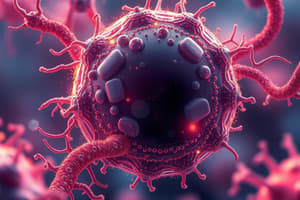Podcast
Questions and Answers
Which organelle releases energy for the active transport of mineral ions from the soil?
Which organelle releases energy for the active transport of mineral ions from the soil?
mitochondria
Where does photosynthesis mainly occur in a plant cell?
Where does photosynthesis mainly occur in a plant cell?
- Chromosome
- Cell wall
- Chloroplast (correct)
- Cell membrane
Oxygen produced during photosynthesis diffuses out of the leaves through the stomata.
Oxygen produced during photosynthesis diffuses out of the leaves through the stomata.
True (A)
What is the primary function of gill filaments in fish?
What is the primary function of gill filaments in fish?
What is the main difference between eukaryotic cells and prokaryotic cells?
What is the main difference between eukaryotic cells and prokaryotic cells?
Diffusion is the movement of particles from an area of low concentration to an area of high concentration.
Diffusion is the movement of particles from an area of low concentration to an area of high concentration.
_______ is the site of protein synthesis in a cell.
_______ is the site of protein synthesis in a cell.
Match the following cell components with their descriptions:
Match the following cell components with their descriptions:
Flashcards are hidden until you start studying
Study Notes
Cell Biology
- Eukaryotic cells: have genetic material (DNA) in a nucleus, examples include animal and plant cells
- Prokaryotic cells: do not have a nucleus, have a single loop of DNA, examples include bacteria
- Cell components:
- Cell membrane: controls movement of substances in and out of the cell
- Nucleus: contains DNA
- Mitochondria: where energy is released through respiration
- Cytoplasm: jelly-like substance where chemical reactions happen
- Cell wall (plants): made of cellulose, strengthens the cell
- Chloroplasts (plants): contain chlorophyll, absorb light energy for photosynthesis
- Permanent vacuole (plants): contains cell sap
- Ribosomes: site of protein synthesis
Microscopy
- Light microscope: uses light to form images, relatively cheap, low magnification, low resolution
- Electron microscope: uses a beam of electrons to form images, expensive, high magnification, high resolution
- Magnification calculation: magnification = image size / actual size
Specialised Cells
- Differentiation: cells in animals and plants differentiate to form different types of cells
- Examples of specialised cells:
- Sperm cell: has lots of mitochondria to release energy, no nucleus, and a tail to swim to the ovum
- Red blood cell: contains haemoglobin that binds to oxygen, flat bi-concave disc shape to increase surface area-to-volume ratio
- Muscle cell: contains protein fibres that can contract, relax, and shorten the cell
- Nerve cell: has branched endings (dendrites), impulses, and a myelin sheath to insulate the axon
- Root hair cell: absorbs mineral ions and water, has a long projection to increase surface area
Transport
-
Diffusion: the spreading of particles from an area of higher concentration to an area of lower concentration
-
Osmosis: the diffusion of water from a dilute solution to a concentrated solution through a partially permeable membrane
-
Active transport: the movement of particles from an area of lower concentration to an area of higher concentration using energy from respiration
-
Factors affecting diffusion rate: difference in concentration, temperature, and surface area of the membrane
-
Examples of transport:
- Oxygen diffuses from the air into the blood in the capillaries through the process of diffusion, which occurs due to the concentration gradient between the air and the blood. This process is essential for the body's use of oxygen for cellular respiration.
- Carbon dioxide diffuses from the blood in the capillaries into the air through the process of exhalation. This occurs because the concentration of carbon dioxide in the blood is higher than in the air, causing the molecules to move from an area of higher concentration to an area of lower concentration.
- Nutrients from the small intestine diffuse into the capillaries and are absorbed into the bloodstream. This process is facilitated by the villi and microvilli in the small intestine, which increase the surface area for absorption.
- Urea diffuses from cells into the blood for excretion in the kidney, where it is removed from the body through the process of urination. The kidneys play a crucial role in maintaining proper levels of urea in the bloodstream.
- Active transport is used to absorb mineral ions into the root hair cells of plants. This process is driven by the ATP-dependent pumps that transport ions against their concentration gradient.
Studying That Suits You
Use AI to generate personalized quizzes and flashcards to suit your learning preferences.




